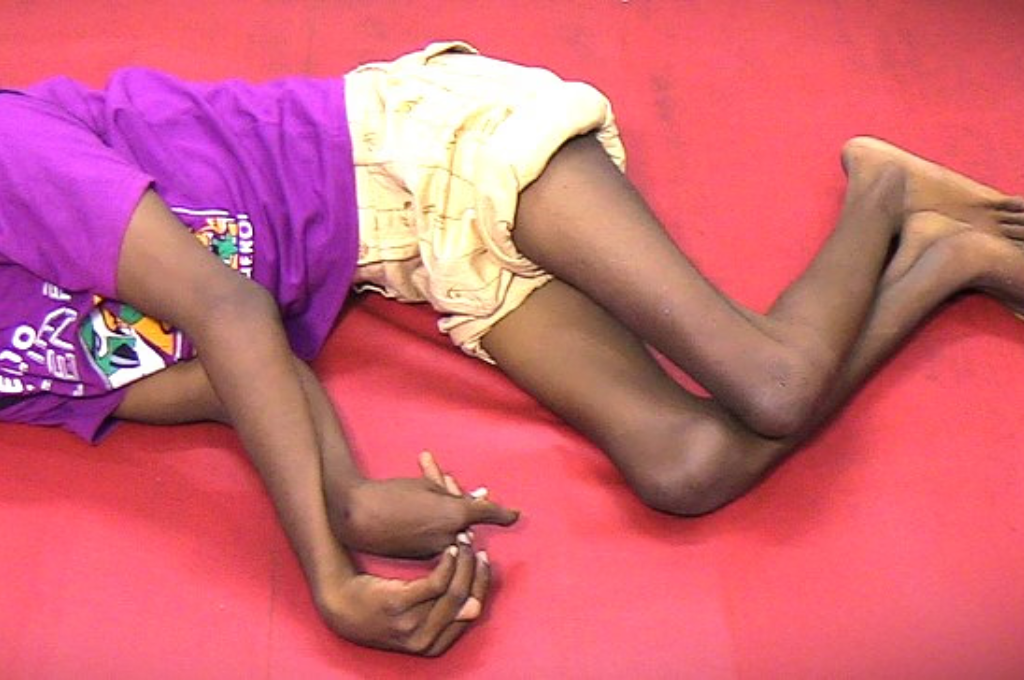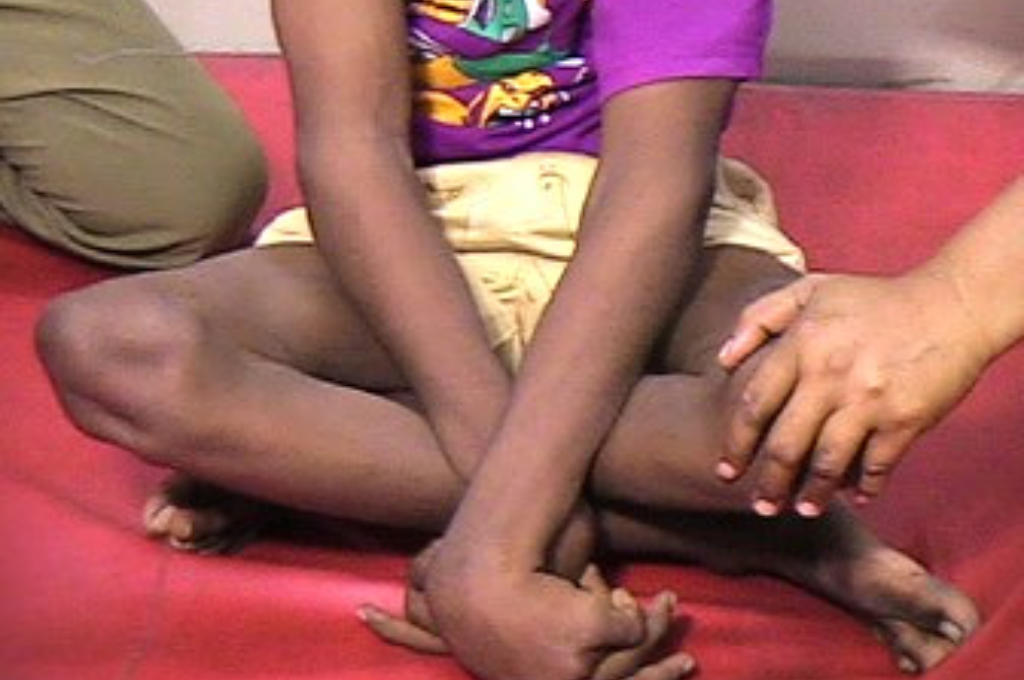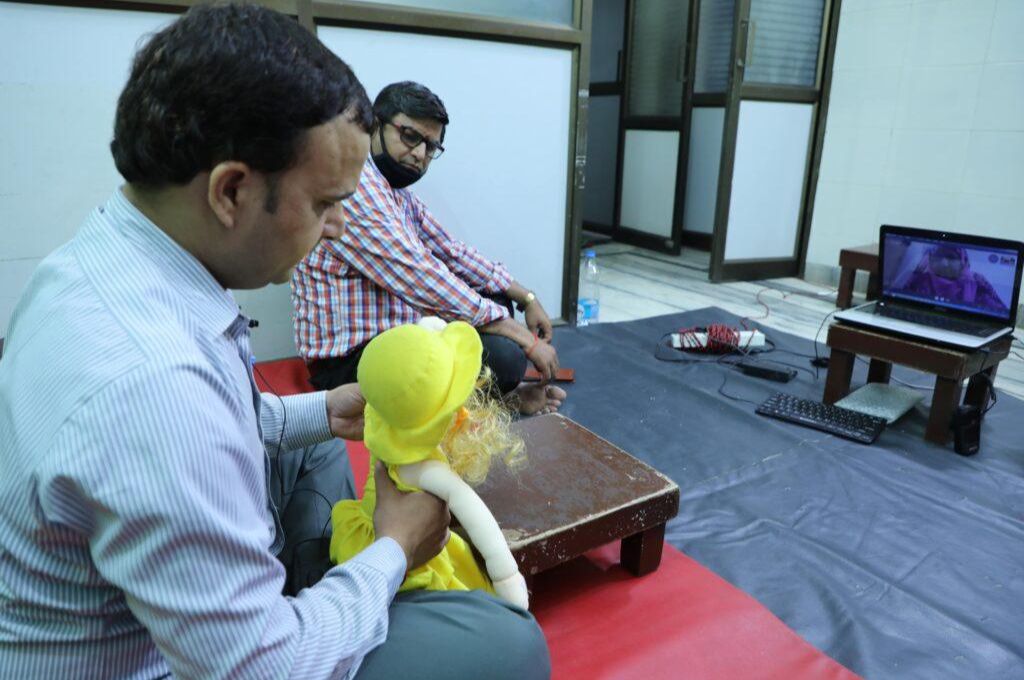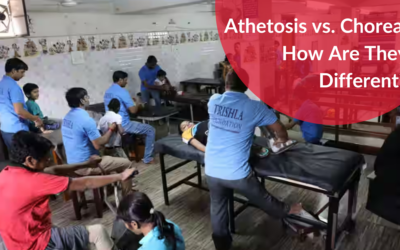What is Spastic Quadriplegia Cerebral Palsy?

Spastic Quadriplegia Cerebral Palsy is a specific type of cerebral palsy, a neurological disorder affecting body movement and muscle coordination. In spastic quadriplegia, individuals experience muscle stiffness (spasticity) in all four limbs – both arms and both legs. This condition is often caused by damage to the brain’s motor control centers, leading to challenges in movement and coordination.
Symptoms
Muscle Stiffness (Spasticity)
Individuals with spastic quadriplegia cerebral palsy often exhibit increased muscle tone, leading to stiffness and resistance during movement.
Impaired Motor Skills
Fine and gross motor skill challenges affect tasks such as grasping objects, reaching, and walking.
Limited Mobility
The difficulty in voluntary movement can impact activities like crawling, walking, or sitting without support.
Involuntary Movements
Individuals may experience uncontrollable, jerky movements due to muscle spasms.
Impaired Coordination
Difficulty coordinating movements, impacting activities requiring precise control like eating, clothing, etc.
Speech and Communication Challenges
Some individuals may experience difficulties in speech and communication due to muscle control issues.
Diagnosis
Clinical Assessment: A healthcare professional, often a pediatrician or neurologist, conducts a thorough clinical assessment, observing the child’s motor skills, reflexes, and overall development.
Medical History
Gathering information about the child’s prenatal, perinatal, and postnatal history to identify potential risk factors or events that may have contributed to the condition.
Neuroimaging Studies
Imaging studies such as MRI or CT scans are employed to examine the brain structure and identify any abnormalities that may have resulted in spastic quadriplegia cerebral palsy.
Developmental Assessments
Evaluate the child’s developmental milestones to identify delays or deviations from typical motor and cognitive development.
Multidisciplinary Evaluation
In many cases, a multidisciplinary team, including physical therapists, occupational therapists, speech-language pathologists, and pediatric orthopedic surgeons, collaborates to assess the child’s abilities and challenges comprehensively. Early diagnosis is crucial to initiate timely interventions and therapies tailored to the individual’s needs. The diagnostic process aims to provide a comprehensive understanding of the condition, guiding the development of an effective treatment plan for improved outcomes.
Causes & Risk Factors
The causes and risk factors associated with Spastic Quadriplegia Cerebral Palsy are multifaceted, often involving a combination of genetic and environmental factors. Understanding these factors is crucial for early detection and intervention. Here are key aspects related to the causes and risk factors:
Causes
1. Prenatal Factors
Premature Birth
Babies born prematurely are at a higher risk of cerebral palsy, including spastic quadriplegia cerebral palsy, as the brain may not have completed its development.
Intrauterine Infections
Infections during pregnancy, such as rubella or cytomegalovirus, can increase the risk of brain damage in the developing fetus.
2. Perinatal Factors
Complications during birth
Factors such as prolonged delivery, oxygen deprivation (asphyxia), or trauma during birth can contribute to cerebral palsy.
3. Postnatal Factors
Infections and Illnesses
Infections or illnesses during early childhood that affect the brain can contribute to the development of cerebral palsy.
Head Injuries
Traumatic brain injuries occurring after birth can result in cerebral palsy.
Risk Factors
Low Birth Weight
Babies with a low birth weight are at an increased risk, as low birth weight is often associated with premature birth and developmental challenges.
Multiple Births
Twins, triplets, or higher-order multiples have a higher risk of cerebral palsy, often due to the increased likelihood of premature birth or complications during delivery.
Maternal Health
Infections during Pregnancy
Maternal infections, particularly those affecting the developing fetus, can contribute to brain damage.
Genetic Factors
Certain genetic factors may increase the susceptibility to cerebral palsy.
Complications during Pregnancy
Conditions such as preeclampsia, which affects the mother’s blood pressure, can contribute to the risk of cerebral palsy.
Rh Incompatibility
Rh incompatibility between the blood types of the mother and the baby can increase the risk of cerebral palsy.
Bleeding in the Brain
Intracranial hemorrhage in the baby’s brain, often associated with trauma or oxygen deprivation, is a significant risk factor. It’s important to note that while these factors can increase the risk, cerebral palsy, including spastic quadriplegia cerebral palsy, can still occur without identifiable causes. Early intervention and comprehensive care, including physical therapy, medical management, and support for families, can significantly improve outcomes for individuals with spastic quadriplegia cerebral palsy.
Treatment
The treatment for Spastic Quadriplegia Cerebral Palsy aims to improve the individual’s functional abilities, manage symptoms, and enhance overall quality of life. The approach is often multidisciplinary, involving various therapeutic modalities, medical interventions, and support services. Here are standard treatment options for individuals with spastic quadriplegia cerebral palsy.
1. Physical Therapy
Goal
Improve muscle strength, flexibility, and overall mobility.
Approach
Customized exercises and therapeutic activities designed to address specific motor challenges.
Benefits
It enhances motor skills, reduces muscle spasticity, and promotes independence in daily activities.
2. Occupational Therapy
Goal
Enhance fine motor skills and promote independence in activities of daily living.
Approach
Targeted activities to improve hand-eye coordination, grasp, and fine motor skills.
Benefits
Occupational therapy facilitates greater independence in self-care tasks and improves overall functional abilities.\
3. Speech Therapy
Goal
Address communication challenges and improve speech and language skills.
Approach
Exercises to strengthen oral muscles, use of communication devices, and strategies to improve articulation.
Benefits
It enhances the individual’s ability to express themselves and communicate effectively. It also improves chewing and swallowing and reduces the dribbling of saliva.
4. Medications
Goal
Manage muscle spasticity and reduce stiffness.
Types
Muscle relaxants, anti-spasticity medications.
Benefits
It helps improve comfort, ease of movement, and overall mobility.
5. Orthopedic Interventions
Goal
Address musculoskeletal issues and prevent complications such as joint contractures, muscle shortening, and angular and rotational deformity of bone.
Interventions
Orthopedic surgeries, including tendon lengthening, tendon transfer, osteotomy, joint reconstruction, and other surgical interventions.
Benefits
It improves joint mobility and reduces the risk of skeletal deformities.
6. Assistive Devices and Adaptive Technology
Goal
Enhance independence and facilitate daily activities.
Devices
Mobility aids (wheelchairs, walkers, elbow crutches, sticks, etc), communication devices, and adaptive tools.
Benefits
It enables individuals to navigate their environment, communicate effectively, and participate in various activities.
7. Recreational and Therapeutic Activities
Goal
Encourage social interaction, recreation, and overall well-being.
Activities
Adapted sports, art therapy, music therapy, and other recreational programs.
Benefits
Promotes social inclusion, boosts self-esteem, and enhances overall quality of life.
8. Counseling and Psychosocial Support
Goal
Address emotional and psychological well-being.
Services
Counseling, support groups, and resources for individuals and families.
Benefits
Provides emotional support, coping strategies, and a sense of community.
9. Clinical Trials and Research Participation
Goal
Contribute to advancements in treatment options.
Opportunities
Participation in clinical trials and research studies.
Benefits
It may provide access to cutting-edge treatments and contribute to broader scientific understanding. Treatment plans are individualized based on the specific needs and challenges of each person with spastic quadriplegia cerebral palsy. Regular monitoring, adjustments to interventions, and a collaborative approach involving healthcare professionals, families, and the affected individuals contribute to the most effective outcomes.
Distinguishing Spastic Quadriplegia CP with other Types
Spastic Quadriplegia Cerebral Palsy differs from other types of cerebral palsy in its extent of motor impairment and the areas of the body affected. Here are the key distinctions between spastic quadriplegia cerebral palsy and other types of cerebral palsy:
1. The extent of Motor Involvement
Spastic Quadriplegia
Involves motor impairments in all four limbs—both arms and both legs. Individuals with spastic quadriplegia cerebral palsy typically experience widespread muscle stiffness, affecting various muscle groups throughout the body. They have more problems performing daily activities in comparison to other varieties.
Other Types (e.g., Spastic Diplegia, Hemiplegia)
These types may involve motor impairments in specific areas of the body. For example, spastic diplegia primarily affects the lower limbs, while hemiplegia impacts one side of the body.
2. Severity of Involvement
Spastic Quadriplegia
It is often considered the most severe form of cerebral palsy due to the widespread motor impairment. Individuals with spastic quadriplegia cerebral palsy may face significant challenges in mobility, coordination, and daily activities.
Other Types
The severity varies among different types of cerebral palsy. Some individuals may have milder symptoms and greater functional abilities compared to those with spastic quadriplegia cerebral palsy. The hemiplegic variety is the mildest one. Depending upon the severity, Diplegics can manage their routine work with or without support.
3. Impact on Fine and Gross Motor Skills
Spastic Quadriplegia
Challenges in both fine and gross motor skills. This includes difficulties in tasks requiring precision, such as grasping objects, and broader activities, like walking and sitting without support.
Other Types
The impact on fine and gross motor skills depends on the specific areas of the body affected. For instance, spastic diplegia primarily affects lower limb coordination. In hemiplegic upper limb involvement, the function of one hand is greatly affected.
4. Associated Complications
Spastic Quadriplegia
It is more likely to be associated with complications such as severe muscle spasticity, joint contractures, hip dislocation, and orthopedic issues due to extensive muscle involvement.
Other Types
Complications may vary and could include issues related to specific motor impairments, such as gait abnormalities in spastic diplegia. In the hemiplegic variety, it is much less likely to get other issues.
5. Mobility and Independence
Spastic Quadriplegia
Individuals may have significant challenges in mobility and may require assistive devices for daily activities. Achieving independence in mobility tasks can be more demanding. In adulthood, most of them require a wheelchair for mobility.
Other Types
The impact on mobility and independence depends on the specific type of cerebral palsy. Some individuals may achieve greater independence with appropriate interventions. Hemiplegic and mildly affected Diplegic are more likely to be independent in adulthood.
6. Speech and Communication Challenges
Spastic Quadriplegia
Speech and communication challenges may be more pronounced due to the widespread muscle involvement, affecting oral motor control.
Other Types
Speech and communication challenges can vary, and individuals may exhibit difficulties based on the specific motor impairments they experience. Dyskinetic variety has greater problems in speech. Hemiplegic have fewer problems.
7. Overall Functional Impact
Spastic Quadriplegia
Has a broader impact on overall functionality, including daily living activities, communication, and mobility.
Other Types
The functional impact is specific to the areas of the body affected, and individuals may have a wider range of functional abilities depending on the type of cerebral palsy.
Prognosis
The prognosis for individuals with Spastic Quadriplegia Cerebral Palsy varies based on various factors, including the severity of symptoms, the effectiveness of interventions, and the individual’s overall health. It’s important to note that cerebral palsy is a lifelong condition, and while the symptoms may persist, proactive management and support can significantly improve the individual’s quality of life. Here are key aspects related to the prognosis:
1. The severity of Symptoms
The degree of motor impairment and associated challenges influence the prognosis. Individuals with severe spastic quadriplegia cerebral palsy may experience greater difficulties in mobility, communication, and daily activities.
2. Early Intervention
Early and comprehensive intervention, including physical therapy, occupational therapy, and medical management, can positively impact outcomes. Early identification and intervention aim to address developmental challenges and enhance functional abilities.
3. Treatment Adherence
The individual’s adherence to recommended treatments and therapies affects the cerebral palsy prognosis. Regular physical therapy, medications to manage spasticity, and orthopedic interventions can improve mobility and overall well-being.
4. Orthopedic Complications
Addressing and managing orthopedic complications, such as joint contractures and skeletal deformities, can impact the long-term prognosis. Surgical interventions may be considered to improve joint mobility. The quality of orthopedic surgery matters for the long-term outcome.
5. Speech and Communication Support
Individuals with spastic quadriplegia cerebral palsy may face challenges in speech and daily communication. Speech therapy and augmentative and alternative communication (AAC) devices can enhance communication skills, positively influencing the prognosis.
6. Adaptive Technology and Assistive Devices
Integrating adaptive technology and assistive devices tailored to the individual’s needs can significantly enhance independence and functional abilities.
7. Cognitive Function
Spastic quadriplegia cerebral palsy primarily affects motor function, and cognitive abilities are generally not directly impacted. However, the prognosis may be influenced by the individual’s cognitive function and the ability to adapt to various challenges.
8. Quality of Life and Social Support
The prognosis is also influenced by the individual’s access to social support, educational opportunities, and resources. A supportive environment that promotes inclusion and addresses emotional well-being improves quality of life.
9. Transition to Adulthood
As individuals with spastic quadriplegia cerebral palsy transition to adulthood, the prognosis is influenced by the availability of appropriate services, vocational support, and community engagement opportunities.
10. Research and Innovation
Ongoing research and innovations in treatments, therapies, and assistive technologies may introduce new possibilities for individuals with spastic quadriplegia cerebral palsy, potentially improving long-term outcomes. It’s essential to approach the prognosis for spastic quadriplegia cerebral palsy with a comprehensive and individualized perspective. Regular assessments by healthcare professionals, collaborative care, and a supportive network contribute to optimizing the individual’s potential and achieving the best possible quality of life.





